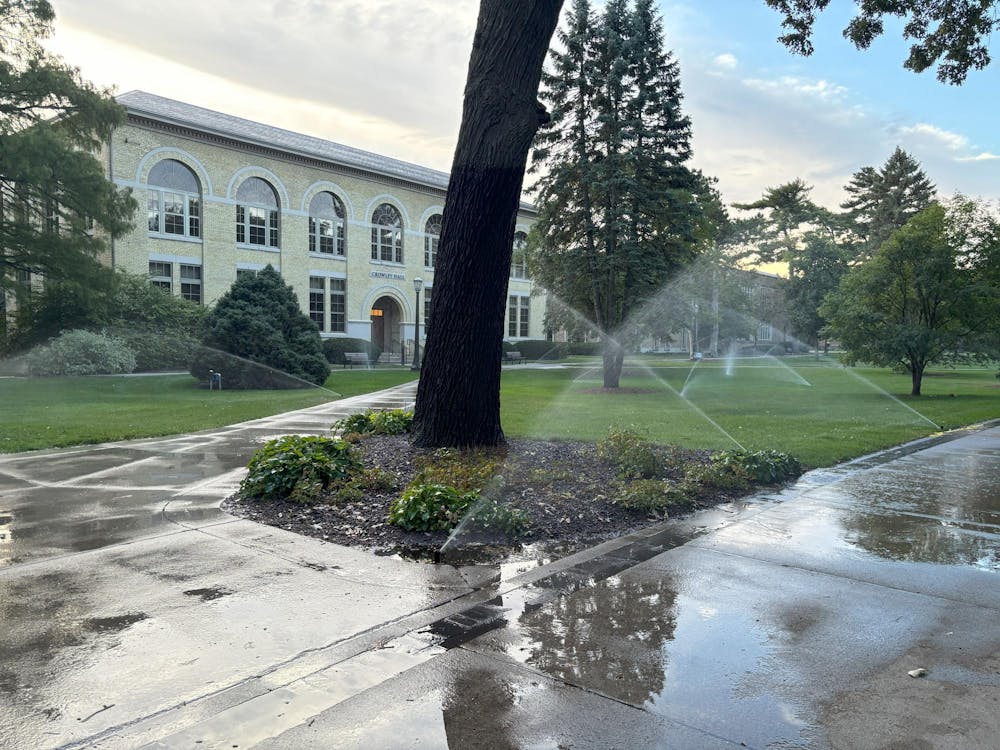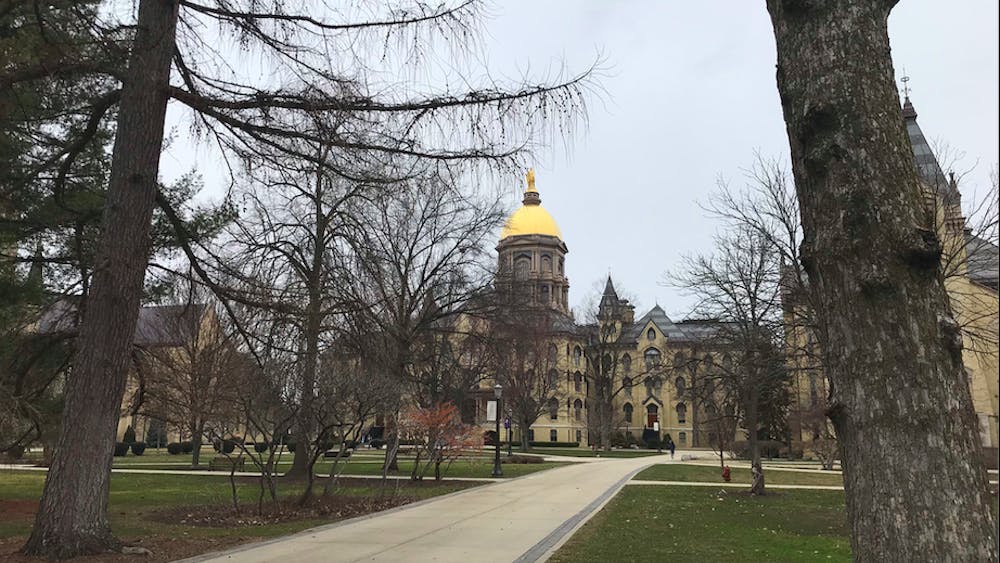The fall semester has been graced by student applause for the newly inaugurated president Fr. Robert Dowd, cheers for the 3-1 Notre Dame Fighting Irish and, unfortunately, complaints about sprinklers. The water irrigation systems at both Notre Dame and Saint Mary’s campuses have been catalysts for frustration and nervous fervor.
According to the Notre Dame director of grounds and landscape Beau Barnett, the water irrigation system has been operating on a higher frequency on account of the drought last month. While the grass around campus has been green, students have been soaked.
“They make me so mad,” Notre Dame sophomore Kaitlyn Dooley said. “There’s got to be a way to make them actually hit the grass rather than the path half the time.”
According to Dooley, the consistency of the sprinklers compare similarly to the 2023 fall semester.
“I don’t think it's gotten better or worse,” Dooley said. “I mean having God Quad sprinklers on while everyone was taking first day of school pictures, that was quite inconvenient.”
On Aug. 27, the morning of the first day of class, many students gathered on God Quad in front of the Main Building to take photos with their friends. Some students dodged sprinklers as they shot photos, while others waited in line for coveted sprinkler-free photo spots.
“Sprinklers are very similar across our quads,” Barnett wrote in an email. “The frequency of distribution is determined by perception rates. We focus on all areas of campus.”
Saint Mary’s freshman Isabella Cicak recalled her own frequent encounters on the College campus.
“I have had 9 a.m. classes, and while I’m walking past the library, the sprinkler system turns on,” Cicak said. “And, you know, when push comes to shove, I get pretty wet.”
Cicak further noted sprinklers not only cause frustration, but endangered her academic equipment as well.
“My books have not gotten wet, but my bag certainly has,” Cicak said. “I bring my computer bag with me, and that is pretty dangerous.”
Saint Mary’s freshman Colleen Kelley believes that the purpose of the sprinklers seemed unfounded on account of their “wasteful” direction.
“I think they are pretty wasteful because half the water goes on the sidewalk,” Kelley said. “Why are they aimed at the sidewalk in the first place? That’s where people walk.”
According to the Campus Safety and University Operations website, the current irrigation network replaced a 15-year-old system.
“Over the years, the sustainability team has helped Notre Dame prioritize mindful water use, especially via our architectural and utility-related planning and operations,” senior director of sustainability Geory Kurtzhals wrote in a statement. “Specifically regarding the irrigation system, Notre Dame replaced its sprinkler system with a new, high-efficiency system.”
According to Kurtzhals, the system defers irrigation when it is raining, which results in water savings between 25% and 35%. On top of the weather monitoring feature, the system also can shut down a central location water supply in the case of broken pipes or flooding.
Students, however, have noted the sprinklers being on during rainy weather.
Additionally, flow meters are installed across Notre Dame’s campus, which increase savings up to 55%. Flow meters measure the rate of water passing through.
“Due to its high efficiency, the new system will count as a credit toward achieving LEED certification for new buildings,” Kurtzhals wrote. “In May, 2021, landscape services updated its nursery irrigation system, replacing the old overhead operation, resulting in an 80% savings in water.”
According to the United States Green Building Council (USGBC), the Leadership in Energy and Environmental Design (LEED) certifications are used by over 180 countries and territories in order to implement "a framework for healthy, highly efficient and cost-saving green buildings."
“The sustainability office has had a long history of collaborating with our operators on campus,” Kurtzhals wrote. “Notre Dame makes it easy to integrate sustainability-minded decision-making into our ongoing processes through the leadership of our Sustainability Strategy Standing Committee, which includes students, faculty, and staff.”
In response to a question about the sprinklers operating during the day more frequently and on walking paths, Barnett pointed to the drought.
“We have been in a drought situation over the last month [which] creat[es] tough situations for our turf and plant material,” Barnett wrote.
With the past month’s heat wave, Saint Mary's College conducted a ‘Beat the Heat!’ initiative on Aug. 27. This involved cool-down spots, free coffee and a visit from Kona Ice. Additionally, a Sprinkler-Run on Library Green was held to conduct a cooler environment with a light misting along the sidewalks.
Because of these previous events, many Saint Mary’s students assumed the sprinklers’ direction was set to increase cooling in the outdoor heat. However, these suspicions proved false as cooler weather set in.
Notre Dame sophomore Suzanne Santiago compared the sprinkler spraying the paths on hot days to a waterpark.
“I didn’t interact with them too much,” Santiago said. “Honestly, when it was really hot, I didn’t mind them sometimes getting me wet a little bit because it was like a fun refresher. But now, not as much because it’s not as hot.”
Cicak also recounted the sprinkler system not only impacting her academic activities, but also her social activities. During Morrissey Hall’s signature first football game watch-party on South Quad on Aug. 31, the sprinklers began spraying students while gathered on the quad with blankets, futons, chairs and even a bed.
“I remember the first away game, against Texas A&M, the sprinklers went off during the watch party while everyone was sitting on the grass,” Cicak said.
Kelley also commented on the event.
“I was there too,” Kelley said. “People had to move. We left after that.”
Notre Dame junior Jane Miller described her experience being hit by unexpected sprinklers early in the morning as being “ambushed.”
“Why was the sprinkler going in the wee hours of the morning?” Miller said. “I’m confused by that. Maybe they do it at nights, so people don’t get wet during the day.”
However, Miller noted people still get wet from the sprinklers during the day. She stated the sprinklers are always going.
“Sprinklers are usually scheduled to operate during the night, but [they] have been on during the day recently because of the drought,” Barnett wrote.
Barnett noted that the sprinklers are kept on a schedule.
Hayle Jean Baptiste, a senior at Notre Dame, offered a different student perspective on the sprinklers.
“To be honest, it has only happened to me once,” Jean Baptiste said. “I just decided to go around.”
According to Barnett, the sprinklers will remain in operation until about mid-October, in which they will be shut down for the winter season.
“Sprinklers are turned on when added moisture is needed for turf health, typically during dry periods,” Barnett wrote.










